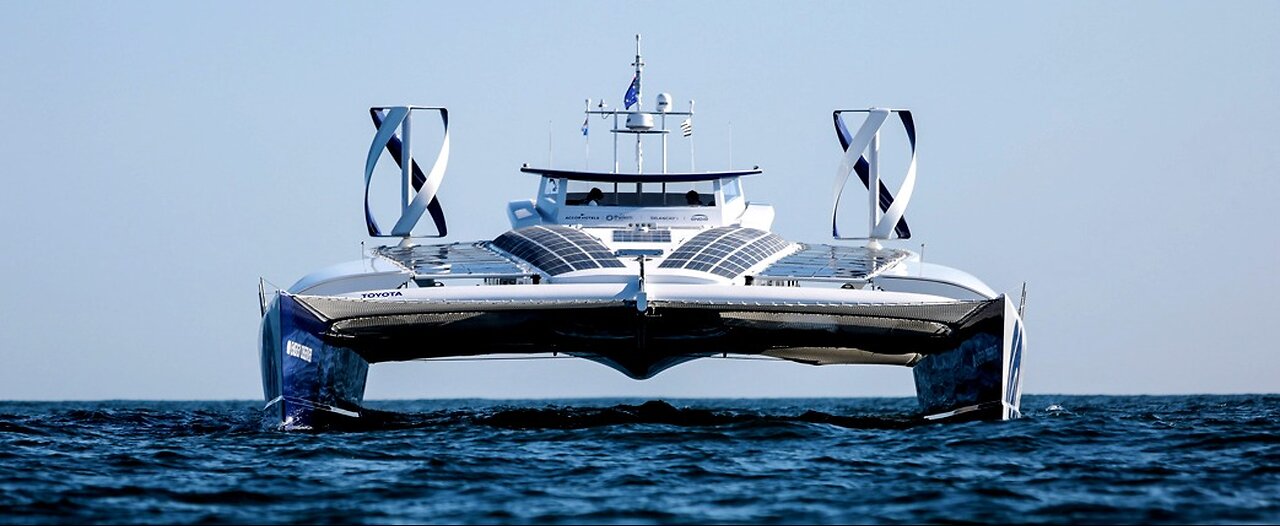Premium Only Content

Wind, Solar, HHO, Powered Boat
Powered by solar, hydrogen, wind and water energy, the white catamaran will take six years to tour the world.
During its stopovers, Energy Observer produced a total of 488 kg, almost ½ ton of hydrogen, during 1496 hours of functioning, that's an efficiency of 42%.
Hydrogen supplied up to 60% of the energy needed for a typical voyage, and the remaining 40% was attributed to solar power, using a fuel cell functioning on average for 6 of each 24 hours of navigation, with an efficiency of 48%
On the sides of the boat are The Oceanwings wings which are going to reduce the vessel's energy consumption, accelerate its speed, and above all, enable it to produce energy and hydrogen while navigating.
The Oceanwings won't only serve as part of the rigging, they will actually increase the vessel's energy efficiency. Their installation on the vessel's two floaters will in fact allow it to:
Increase the speed, by complementing the electric motors
Reduce energy consumption when they are used to compensate the electric motors
Increase energy production during navigation by producing hydrokinetic energy (reversing the electronic motors into hydrogeneraters)
Produce hydrogen during navigation by the electrolysis of water
Up until now, hydrogen production was only possible during stopovers, but the installation of Oceanwings® will make hydrogen production possible while the vessel is navigating. It will only be for 1 to 2 hours a day in the beginning, but introducing hydro-generation by inverting the electric motors is an indispensable power supplement in Northern Europe where the sunlight conditions are not as favorable.
The installation of Oceanwings® on board Energy Observer is the first step to reducing the environmental impact of maritime transportation around the world. According to simulations carried out on a large range of boats, the results are extremely promising: from 18% to 42% less energy is required. An important statistic when one recognises that 90% of global commerce is transported at sea. Maritime transportation is also responsible for large quantities of air pollution, emitting into the atmosphere pollutants such as fine particles, nitrogen oxide (NOx), and sulfur oxide (SOx).
Hydrogen is the most abundant chemical element in the universe. Inexhaustible, it displays exceptional energy density: it releases up to 4 times more energy than coal, 3 times more than diesel and 2.5 times more than natural gas. Its combustion emits neither greenhouse gases nor fine particles. Thus, Energy Observer is the first vessel in the world that is capable of producing its hydrogen on board using sea water, by electrolysis.
-
 1:49:14
1:49:14
Redacted News
5 hours agoTrump is Back! Congress Uncovers New Biden Crimes One Day After He Leaves D.C. | Redacted
126K182 -
 2:09:53
2:09:53
Benny Johnson
5 hours ago🚨President Trump LIVE Right Now Making MASSIVE Announcement At White House News Conference
215K220 -
 2:04:10
2:04:10
Revenge of the Cis
6 hours agoEpisode 1433: Retribution
82.9K13 -
 1:42:50
1:42:50
The Criminal Connection Podcast
9 hours ago $0.57 earnedEddie Hearn talks JOSHUA vs FURY, Working With Frank Warren & The Truth About Turki Alalshikh!
32.4K1 -
 1:00:25
1:00:25
In The Litter Box w/ Jewels & Catturd
1 day agoGolden Age | In the Litter Box w/ Jewels & Catturd – Ep. 724 – 1/21/2025
125K57 -
 57:42
57:42
The Dan Bongino Show
13 hours agoHE'S BACK! (Ep. 2405) - 01/21/2025
1.32M2.1K -
 46:19
46:19
Candace Show Podcast
6 hours agoUH-OH! Elon’s Viral Salute Steals The Inauguration Show | Candace Ep 136
136K354 -
 8:05:01
8:05:01
hambinooo
10 hours agoNO COMMIE TUESDAY
90.3K3 -
 2:08:37
2:08:37
The Quartering
8 hours agoTrump Ends Online Censorship, Foreign Aid, Frees J6 Hostages & Much More In Day 1
130K44 -
 1:33:37
1:33:37
Russell Brand
9 hours agoBudget Cuts, Fires, and the Failures of Leadership – SF523
294K130